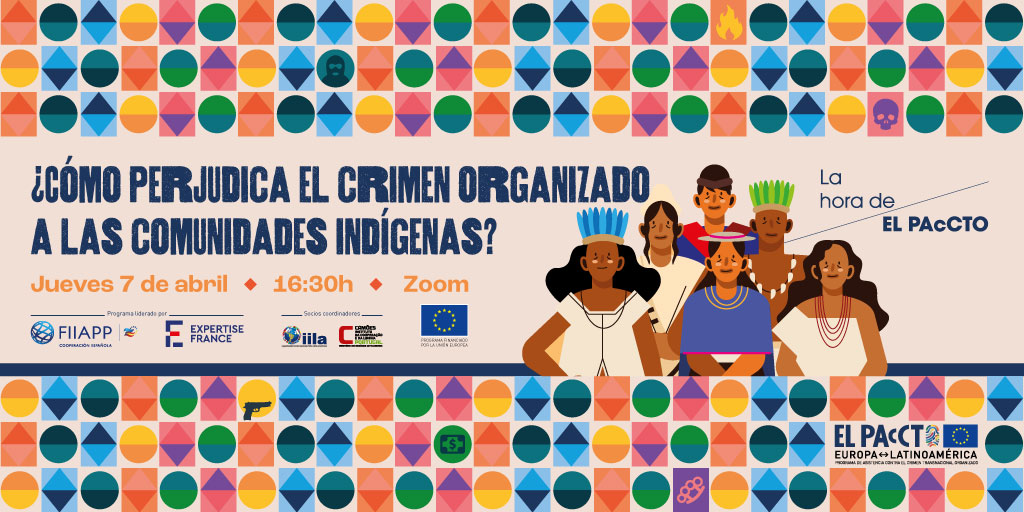The third edition of La hora de EL PAcCTO set out to discuss how organised crime harms indigenous communities, raise awareness of the existence and uniqueness of these communities, their ancient customs, as well as their specific social and security needs.
In addition, the communication space was an opportunity to learn how specific actions carried out by organised groups affect indigenous communities. We have approached this from a different perspective, considering their voices, culture and identity and exploring the damage that the existence of territorial and environmental conflicts on their lands means for indigenous peoples.
The opening event was attended by Jorge de la Caballería, Head of Unit of the DG INTPA of the European Commission. De la Caballería ratified the vital importance of this type of meeting to find solutions to important issues for the two regions. “A rich and complex theme involving all manner of territorial and environmental tensions and also linked to the prison-related problems suffered by these groups.” De la Caballería advocated for seeking efficient strategies to reduce the dangers faced by these communities.
Indigenous communities face discrimination and abuse
The indigenous communities of Latin America and the Caribbean total around 55 million people, accounting for 8.5% of the entire population. It is estimated that there are 522 indigenous peoples in the region, extending from Patagonia to northern Mexico.
To illustrate the real situation of the indigenous communities, Jane Felipe Beltrão, a Brazilian anthropologist, explained that the circumstances in Latin America are critical, since “In the same way as in Central America, in Brazil there are strong, solid, active indigenous movements that create very violent and dangerous situations in the border areas”. The indigenous communities do not acknowledge the artificial borders created by the State, which often leads to conflict”, said Beltrão, explaining the need to help these communities that coexist with the criminal activities of criminal organisations.
Defence of human rights activists
Luciana Peri, coordinator of the EU Protect Defenders programme said that defenders have to deal with a plethora of threats in general and, in particular, those who defend the interests of indigenous peoples.” In most cases, these threats are direct: verbal, digital, persecution, police harassment, physical attacks and/or kidnappings, but criminalisation is a serious problem faced by defenders since the legal actions they they are subjected to by governments, security forces and public officials often discourage them from continuing the fight”.
Ricardo Pael of the Brazilian Public Ministry explained that the low State presence in areas occupied by indigenous communities leaves them vulnerable to becoming victims of organised crime. “There is a lack of geographical boundaries and security, which opens the door to invasion by organised groups that use these lands to exploit their wealth and plant drugs.”
Adrien Ortelli from the Regional Health Agency of France, explained the consequences of illegal mining on the health of these indigenous communities. “There are ten thousand illegal miners in French Guiana who extract ten tons of gold every year, ten times more than legal miners. The mercury used in gold mining pollutes water and soil, which contaminates the food and fish consumed by indigenous people,”
There are studies confirming that some indigenous communities have a high level of mercury in their hair, which has serious effects on the nervous system. “We are talking about insomnia, trembling, memory loss and cognitive and motor dysfunction,” he said.
Indigenous communities and prison problems
Daniel Benítez, Deputy Minister of Criminal Policy of the Paraguayan Ministry of Justice , explained the situation of indigenous communities that are victims of organised crime and the prison issues faced by indigenous inmates, ranging from acculturation and uprooting to organised crime that affects them in the prison environment.
Benítez explained that when indigenous communities face legal problems, they are flung into a system of abandonment, whereby the constitutional regulations demanded for native peoples are not applied to them. They are also sent to the perilous common penal centres for minor offences, which are overcrowded and are not suitable for them. They also suffer discrimination due to their economic, social and cultural situation, which puts them within reach of predatory groups.
The Ministry of Justice of Paraguay is working on new prisons with a different approach, adapted to “condemned communities” and giving them their own space, in which they are classified in a system and environment that recognises their culture, beliefs, ethnicity and human rights.
What can the public administration do?
The natural resources present on indigenous lands have led transnational criminal organisations to step up violent attempts to control and use these areas in recent years. All this has had consequences for these communities and caused an increase in violence, forced displacement, coercion, labour/sexual exploitation and murders, among others.
The studies published by EL PAcCTO on the impact of organised crime on indigenous communities in Latin America, specifically in Brazil, Mexico and Colombia, contain recommendations to improve the situation, such as greater systematisation of information on crimes in indigenous areas so that public agents involved in the fight against crime know that crime detected in the lands of the communities can be effectively addressed.
EL PAcCTO works to seek solutions and agreements between the actors responsible for ensuring the safety of indigenous communities that are marginalised and dispossessed of their lands. In the coming months, the study on Bolivia, Ecuador and Peru will be presented.
